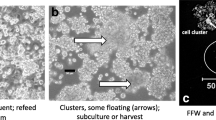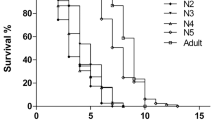Abstract
A Cytophaga-like organism (CLO), isolated from the tick Ixodes scapularis (IsCLO), was adapted to growth in insect cell lines and its antibiotic sensitivity was tested. IsCLO were introduced to four insect cell lines, and their growth was measured by quantitative polymerase chain reaction. IsCLO propagated well in a mosquito cell line, AeAl-2, and caused cytopathic effects in host cells. A lepidopteran cell line, HZ-AM1, was also suitable for propagation of IsCLO and kept a steady state with bacterial growth. Using IsCLO-infected AeAl-2, antibiotics effective against the bacteria included ampicillin, chloramphenicol, penicillin-G, rifampicin, and tetracycline. These antibiotics will be useful for eliminating CLO from host arthropods, which is necessary for in vivo studies of the intracellular facultative symbiotes.
Similar content being viewed by others
Literature Cited
Bandi C, Damiani G, Magrassi L, Grigolo A, Fani R, Sacchi L (1994) Flavobacteria as intracellular symbionts in cockroaches. Proc R Soc Lond B 257:43–48
Bandi C, Sironi M, Damiani G, Magrassi L, Naleapa CA, Laudani U, Sacchi L (1995) The establishment of intracellular symbiosis in an ancestor of cockroaches and termites. Proc R Soc Lond B 259:293–299
Benson M J, Gawronski JD, Eveleigh DE, Benson DR (2004) Intracellular symbionts and other bacteria associated with deer ticks (Ixodes scapularis) from Nantucket and Wellfleet, Cape Cod, Massachusetts. Appl Environ Microbiol 70:616–620
Brooks I, Coolbauch JC, Walker RI, Weiss E (1984) Synergism between penicillin, clindamycin, or metronidazole and gentamicin against species of the Bacteroides melaninogenicus and Bacteroides fragilis groups. Antimicrob Agents Chemother 25:71–77
Conte JE Jr, Barriere SL (1988) Manual of antibiotics and infectious diseases. 6th edn. Philadelphia: Lee & Febiger
Cuchural GJ Jr, Tally FP, Jacobus NV, Gobbach SL, Aldridge K, Cleary T, Finegold SM, Hill G, Iannini P, O’Keeffe JP, Pierson C (1984) Antimicrobial susceptibilities of 1,292 isolates of the Bacteroides fragilis group in the United States: comparison of 1981 with 1982. Antimicrob Agents Chemother 26:145–148
Fallon AM, Stollar V (1987) The biochemistry and genetics of mosquito cells in culture. In: Maramorosch K (ed), Advances in cell culture, vol. 5. New York: Academic Press, pp 97–137
Fenollar F, Maurin M, Raoult D (2003) Wolbachia pipientis growth kinetics and susceptibilities to 13 antibiotics determined by immunofluorescence staining and real-time PCR. Antimicrob Agents Chemother 47:1665–1671
Heath BD, Butcher RDJ, Whitfield WGF, Hubbard SF (1999) Horizontal transfer of Wolbachia between phylogenetically distant insect species by a naturally occurring mechanism. Curr Biol 9:313–316
Hermans PG, Hart CA, Trees AJ (2001) In vitro activity of antimicrobial agents against the endosymbiont Wolbachia pipientis. J Antimicrob Chemother 47:659–663
Hunter MS, Perlman SJ, Kelly SE (2003) A bacterial symbiont in the Bacteroidetes induces cytoplasmic incompatibility in the parasitoid wasp Encarsia pergandiella. Proc R Soc Lond [Biol] 270:2185–2190
Hurst GDD, Hammarton TC, Bandi C, Majerus TMO, Bertrand D, Majerus MEN (1997) The diversity of inherited parasites of insects: the male-killing agent of the ladybird beetle Coleomegilla maculata is a member of the Flavobacteria. Genet Res Camb 70:1–6
Hurst GDD, Bandi C, Sacchi L, Cochrane AG, Bertrand D, Karaca I, Majerus MEN (1999) Adonia variegata (Coleoptera: Coccinellidae) bears maternally inherited Flavobacteria that kill males only. Parasitology 118:125–134
Hurst GDD, Jiggins F (2000) Male-killing bacteria in insects: mechanisms, incidence, and implications. Emerging Infect Dis 6:329–336
Kurtti TJ, Munderloh UG, Krueger DE, Johnson RC, Schwan TG (1993) Adhesion to and invasion of cultured tick (Acarina: Ixodidae) cells by Borrelia burgdorferi (Spirochaetales: Spirochaetaceae) and maintenance of infectivity. J Med Entomol 30:586–596
Kurtti TJ, Munderloh UG, Andreadis TG, Magnarelli LA (1996) Tick cell culture isolation of an intracellular prokaryote from the tick Ixodes scapularis. J Invertebr Pathol 67:318–321
Lenz CJ, McIntosh AH, Mazzacano C, Munderloh U (1991) Replication of Heliothis zea nuclear polyhedrosis virus in cloned cell lines. J Invertebr Pathol 52:227–233
Mitsuhashi J (1981) A new continuous cell line from larvae of the mosquito Aedes albopictus (Diptera, Culicidae). Biomed Res 2:599–606
Munderloh UG, Jauron SD, Fingerle V, Leitritz L, Hayes SF, Hautman JM, Nelson CM, Huberty BW, Kurtti TJ, Ahlstrand GG, Greig B, Mellencamp MA, Goodman JL (1999) Invasion and intracellular development of the human granulocytic ehrlichiosis agent in tick cell culture. J Clin Microbiol 37:2518–2524
Navajas M, Gutierrez J, Bonato O, Bolland HR, Mapangou-Divassac S (1994) Intraspecific diversity of the cassava green mite Mononychellus progresivus (Acari: Tetranychidae) using comparisons of mitochondrial and nuclear ribosomal DNA sequences and cross-breeding. Exp Appl Acarol 18:351–360
Noda H, Koizumi Y, Zhang Q, Deng K (2001) Density of Wolbachia and incompatibility level in two planthopper species, Laodelphax striatellus and Sogatella furcifera. Insect Biochem Mol Biol 31:727–737
Noda H, Miyoshi T, Koizumi Y (2002) In vitro cultivation of Wolbachia in insect and mammalian cell lines. In Vitro Cell Dev Biol 38:423–427
Norris DE, Klompen JSH, Keirans JE, Black WC IV (1996) Population genetics of Ixodes scapularis (Acari: Ixodidae) based on mitochondrial 16S and 12S genes. J Med Entomol 33:78–89
O’Neill S, Hoffmann AA, Werren JH (1997) Influential passengers, inherited microorganisms and arthropod reproduction. New York: Oxford University Press
Weeks AR, Marec F, Breeuwer AJ (2001) A mite species that consists entirely of haploid females. Science 292:2479–2482
Weeks AR, Velten R, Stouthamer R (2003) Incidence of a new sex-ratio-distorting endosymbiotic bacterium among arthropods. Proc R Soc Lond [Biol] 270:1857–1865
White TJ, Bruns T, Lee S, Taylor J (1990) Amplification and direct sequencing of fungal ribosomal RNA genes for phylogenetics. In: Innis MA, Gelfand DH, Sninsky JJ, White TJ (eds) PCR protocols. San Diego: Academic Press, pp 315–322
Yasunaga-Aoki C, Imanishi S, Iiyama K, Kawarabata T (2004) Establishment of phagocytic cell lines from larval hemocytes of the beet armyworm, Spodoptera exigua. In Vitro Cell Dev Biol 40:183–186
Zchori-Fein E, Gottlieb Y, Kelly SE, Brown JK, Wilson JM, Karr TL, Hunter MS (2001) A newly discovered bacterium associated with parthenogenesis and a change in host selection behavior in parasitoid wasps. Proc Natl Acad Sci USA 98:12555–12560
Zchori-Fein E, Perlman SJ, Kelly SE, Katzir N, Hunter MS (2004) Characterization of a ‘Bacteroidetes’ symbiont in Encarsia wasps (Hymenoptera: Aphelinidae): proposal of ‘Candidatus Cardinium hertigii’. Int J Syst Evol Microbiol 54:961–968
Zchori-Fein E, Perlman SJ (2004) Distribution of the bacterial symbiont Cardinium in arthropods. Mol Ecol 13:2009–2016
Acknowledgments
We are grateful to Jun Mitsuhashi of Tokyo University of Agriculture and Chisa Yasunaga-Aoki of Kyushu University for providing their cell lines. This work was supported in part by Grants-in-Aid for Scientific Research (nos. 16580041 and 15380040) from the Ministry of Education, Science, Sports and Culture of Japan.
Author information
Authors and Affiliations
Corresponding author
Rights and permissions
About this article
Cite this article
Morimoto, S., Kurtti, T.J. & Noda, H. In Vitro Cultivation and Antibiotic Susceptibility of a Cytophaga-Like Intracellular Symbiote Isolated from the Tick Ixodes scapularis. Curr Microbiol 52, 324–329 (2006). https://doi.org/10.1007/s00284-005-0349-7
Received:
Accepted:
Published:
Issue Date:
DOI: https://doi.org/10.1007/s00284-005-0349-7




